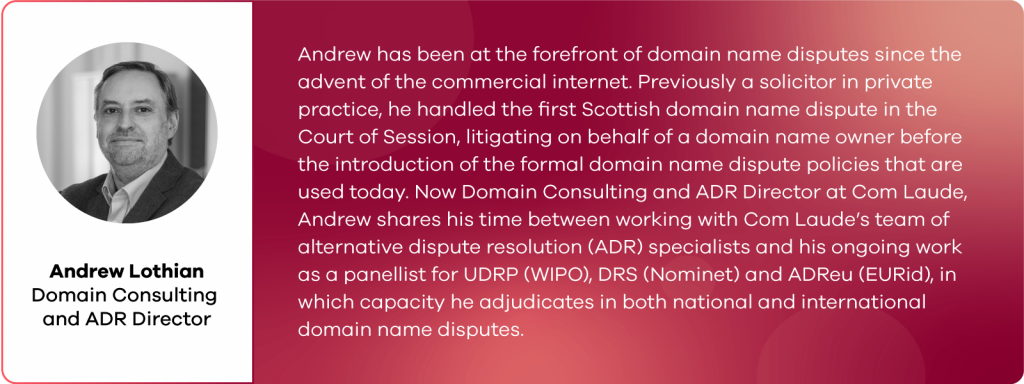Ask The Experts: Domain Name Dispute Resolution
Formal domain name dispute resolution policies, such as the UDRP, DRS and ADReu, were set up to enable brand owners to challenge potentially infringing domain names rapidly and cost-effectively. Andrew Lothian, Domain Consulting and ADR Director at Com Laude, explains how to make the best use of the systems.

What are the biggest trends and challenges in this sector at present?
Domain name abuse is a constant challenge, but there has been a definite rise in fraud cases as a result of the increase in home working during the COVID-19 pandemic. For example, we are seeing a large number of disputes over domains registered that are being used for business compromise scams or phishing emails.
There has also been a spike in cloning or facsimile sites, where the website looks identical to a brand owner’s site, except with a different phone number or contact form. Plus, typosquatting including registrations that include a brand name plus ‘group’ or ‘ltd’, for example, which are typically used to host pay-per-click (PPC) websites.
Domain name monitoring and online brand protection play a crucial role here, and formal domain name dispute resolution policies, such as the UDRP, DRS and ADReu, provide brand owners with a mechanism for challenging and taking down such sites, while recapturing the infringing domain and redirecting its traffic to legitimate use.
![]()
How do the policies work?
While the procedures and wording differ slightly across the different policies, the process and grounds are pretty similar.
- First, you need to establish your rights to the name; for example, a registered trademark or evidence of unregistered rights. If the domain in question is a typo, you also have to demonstrate confusing similarity.
- Second, you have to prove that the respondent does not have rights in the name. Essentially, this means providing a prima facie case to prove a negative, which can be a challenge for brand owners and their advisers. To argue this successfully requires you to think ahead to eliminate all the possible ways that the respondent may argue that it does have rights; in other words, to anticipate their response, and to try not to leave any uncertainty in your arguments.
- Finally, you must demonstrate that the registration was made in bad faith (or is an ‘abusive registration’, depending on which policy you are using). Here, it’s all about evidence gathering, especially when it comes to older registrations that you may not have spotted before or which were dormant and have suddenly become active.
The cases are adjudicated via written submission only, so it’s crucial to present your case clearly, logically and according to the rules, and to take the time to provide the evidence to support your arguments.
There can be quite a bit of detective work involved to build up the evidence and background needed for watertight submissions, but it’s crucial not to overlook this step. By creating a chronology of what has happened and taking the time to set out the argument and supporting evidence clearly, you’re also making it easier for the panel to review and decide the case.
This is often easier said than done. Not all in-house legal departments or law firms have specialists in this area; indeed the work to write the submissions can often be passed down to more junior members of a team. This isn’t the case at Com Laude, where customers have access to a senior team with more than 40 years of experience in domain names.
How do your experiences as a panellist feed into this service?
As a panellist, you receive a wide range of really interesting cases from all over the world, but you also see the same issues in the submissions when it comes to the quality of the arguments, responses and supporting evidence. Typically, I will decide between 4-5 cases each month and each case needs to be reviewed within a set time (14 calendar days) and can include vast amounts of supporting evidence.
Of course, panellists will always do their best with what they get, but my advice is always to write a clear, precise and well-evidenced submission to make it as easy as possible for the panellist to decide. This is the basis on which Com Laude’s ADR service works.
My work as a panellist helps me to feed into those submissions and I advise on any complex cases. However, there are strict conflict checks in place at Com Laude to ensure that any cases I take are completely independent of our work.
Are there any common pitfalls to avoid?
A common pitfall for brand owners and their legal advisers is to approach a domain name policy complaint from a trademark ownership perspective only. This can have two major shortfalls:
- First, it is surprising how often complainants overlook the need to provide that crucial piece of evidence to support their rights to their name. They just assume they own the brand ‘because it’s our name’ and that the panellist will know their company, but they don’t back that up with any actual evidence in the submission or take the time to establish it.
- Second, and as common, brand owners often approach the complaint as if it’s a pure trademark infringement case. It’s important to keep in mind that the policies are centred around whether the domain is being abused or registered in bad faith, which is not necessarily the same thing as trademark infringement. Trademarks are territorial, so if two companies happen to have the same name, it doesn’t mean that the registration by one of them is automatically abusive to the other.
Working with a domain name specialist is important here because there is a risk that pursuing a case without the requisite knowledge or on the wrong basis could lead to a ruling of reverse domain name hijacking (RDNH).
What is RDNH?
Reverse domain name hijacking (RDNH) has been included in the UDRP since its inception and essentially functions to give balance to the process and stop bad faith complaints. Such a ruling will be given if, for instance, a company makes a complaint that was doomed to failure because it knew (or should have known) that the respondent was innocent of the charge. An example of this might be if a brand owner brings a complaint against another company that has a trademark right to the name that predates its own registration.
Of course, it’s understandable that a brand owner may see a domain name registration that is confusingly similar to its own and jump to the conclusion that it has been registered in bad faith. But, while many infringing registrations are just that, it is not always the case. You have to look into the respondent’s circumstances to establish whether the registration was indeed made in bad faith or if the other party does have rights to the name. Of course, the bad guys also do their best to look as legitimate as possible, so part of the skill of an ADR specialist like Com Laude is to establish the truth. We’ve found, for instance, examples of cloned companies being used to cloak infringers and issues with materials provided as ‘evidence’.
First and foremost, it’s important to know who you’re dealing with, and the WHOIS dark-out has also added somewhat to this sense of a ‘Russian doll’ scenario. You receive the redacted (registrant) details once you file a complaint, and you must act on that revealed information if it turns out the respondent is a legitimate registrant. On the other hand, it also happens that a respondent will come back to say they had no knowledge their name was even being used on the domain name registration, so proper investigation is key. If you pursue your complaint against a legitimate registrant at this point without proving otherwise, it is likely that RDNH could be found. This can result in quite a lot of bad press and informed respondents will be sure to raise such a finding against you in future disputes.
What would be your main piece of advice in how to approach ADR policies?
The ADR policies were designed to be used by everyone, but I would always advise companies to get an opinion from a specialist before jumping in. There is presently no right to appeal UDRP rulings and a single point of appeal in the DRS, so it’s important to get it right the first time. It’s also very important to take advice on how to present your submission, as well as to obtain expert assistance for the evidence gathering needed to support it.
Working with a domain name specialist, such as Com Laude, can also be preferable to working with a traditional trademark adviser, who might not have the expertise in drafting or access to (or knowledge of) the relevant technology to gather evidence, such as DNS records. Likewise, going in ‘all guns blazing’ with cease and desist letters may not always be the best approach when the emphasis is placed on written submissions. In some cases, it also makes sense to wait on the outcome of cases already in the system. An example of this is the recent cases regarding the .sucks gTLD.
Finally, it’s important to consider your strategy for disputes in light of your wider approach to corporate domain name management. Ideally, you want to block any obvious variants, such as new gTLDs, before they get to the stage where you need to dispute them.
To find out more about Com Laude’s ADR services, please contact us.
